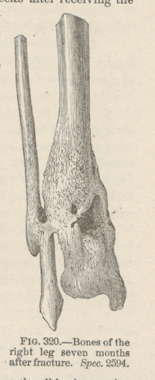Title: Holmes, W.
Source text: The Medical and Surgical History of the War of the Rebellion. (1861-65.), Part 3, Volume 2 (Washington, DC: Government Printing Office, 1883), 545.
Civil War Washington ID: med.d2e20941
TEI/XML: med.d2e20941.xml
CASE 793.—Private W. Holmes, Co. D, 18th Massachusetts, aged 20 years, was wounded in the right leg, at Fredericksburg, December 13, 1862. He passed from a field hospital to Campbell Hospital, Washington, two weeks after receiving the injury, and six months afterwards he was transferred to Mower Hospital, Philadelphia. Surgeon J. Hopkinson, U. S. V., in charge of the latter, recorded the following history: "The patient was suffering from a compound comminuted fracture of the tibia and fibula at the lower third. He also complained of diarrhœa, for which chalk mixture and laudanum were administered. Dead bone was discovered by the probe. The leg had been operated on and several pieces of bone removed. At the time of admission, June 20th, it was very much enlarged and disfigured by cicatrices. The wound was dressed with warm-water poultices every hour. On July 15th a large ulcer had broken out on the limb and a large piece of bone was taken away. Warm-water dressings were still continued, and the foot was kept elevated. On the following day the ulcer was found to be extending, and bread and milk poultices were ordered to be applied. Subsequently chlorate of potassa and muriatic disinfecting lotion were used. On July 19th, creasote was applied to the ulcer; warm-water dressings continued; bone now in a sad state. On July 22d the leg was removed by flap operation by Assistant Surgeon C. R. Greenleaf, U. S. A., half way between the ankle and the knee. The flaps were brought accurately together and dressed with water dressing. On the following day the patient felt easy, having slept well during the night after taking a half grain of morphia; pulse 100, full and soft. On July 26th the dressing was removed; stump looking well and patient doing well. Extra diet was given, and porter daily. The stump healed rapidly and the patient's general health was excellent. On September 30th the stump had entirely healed and the patient went home on furlough." He was subsequently transferred to Haddington Hospital, and later to Ladies Home, New York City, where he was supplied with an artificial leg of the "Ely" pattern, and whence he was discharged April 12, 1864, and pensioned. In his subsequent applications for commutation he described the condition of the stump as continuing in a "healthy state." The amputated bones of the leg (Spec. 2594), contributed by the operator, are represented in the annexed wood-cut (FIG. 320) and exhibit the seat of the fracture, the fibula being firmly consolidated, and much callus being effused about the tibia, but caries having prevented firm union. The pensioner was paid March 4, 1881.
